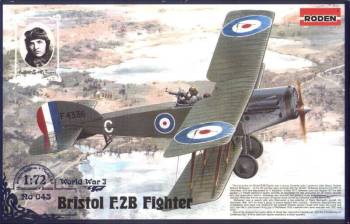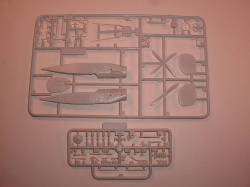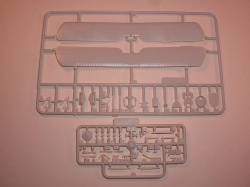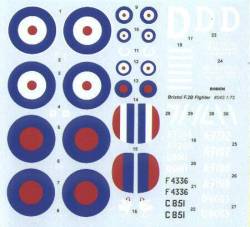Roden's 1/72nd Bristol F.2B Fighter |  | History Compared to many World War One aeroplanes, a great deal of research exists on the Bristol F.2B: there is in fact, a two-volume Datafile Special by J. M. Bruce on this subject of which I have seen the first. The F.2B contained improvements compared with its predecessor, the F.2A: these included a re-shaping of the area in front and behind the pilot's cockpit that allowed a better forward view, new horizontal tail surfaces, a Scarff ring mounting for the gunner's cockpit and a new radiator. The main deliveries of the Bristol F.2B started took place in mid-1917 and in July 1917 the Bristol F.2B became the RFC's standard fighter-reconnaissance aeroplane and gained its deserved reputation for outstanding performance. So much so that it continued in service in a fair number of different countries for an extended period following the end of World War One, with the RAF using it until 1932. The Kit  Only a couple of injection mould kits are available for the Bristol F.2B in 1/72nd scale. The first is the venerable old Airfix kit, which is inexpensive, inaccurate and past its time. The second is the more recent short-run production by Pegasus, which I have not seen but which costs 13.99 U.K. pounds (approximately US$22). The Roden kit will cost between US$8 and US$10, depending upon where you buy it. Only a couple of injection mould kits are available for the Bristol F.2B in 1/72nd scale. The first is the venerable old Airfix kit, which is inexpensive, inaccurate and past its time. The second is the more recent short-run production by Pegasus, which I have not seen but which costs 13.99 U.K. pounds (approximately US$22). The Roden kit will cost between US$8 and US$10, depending upon where you buy it.
The box contains four sprues of pale grey plastic, a set of clear and detailed instructions, and decals for six schemes. The plastic on the sprues looks excellent. They are finely moulded, contain little flash (all of which can be removed easily) and there are few moulding flaws. Interestingly, unlike that on the Roden SE5a, the radiator detail is clear and crisp, coming as a separate insert into the piece that goes onto the front of the fuselage. I laid the wings and fuselage over the plans in J. M. Bruce's Datafile Special, Volume 1: the dimensions look fine. It is difficult to say whether the model's fuselage has the correct depth and shape but it certainly looks as though it does. The kit contains numerous options including a two and four bladed propeller, and short and long side-exhausts. There are plenty of cockpit interior pieces including a control stick, pilot seat that sits on a box, bench for the gunner/observer, instrument panel, ammunition drums, and foot rudder. There is no cockpit "floor" so the control stick and foot rudder go straight into the fuselage. Usually, I solve this problem by skinning the cockpit floor with a piece of card painted to look like wood, which also covers the inside seam that might be seen otherwise. One minor issue will be the removal of the molding plugs that are on the fuselage interior: some work with a Dremel, sand paper and hobby knife should rectify this problem. In my view, the jewel of this kit is the option to have the engine uncovered: the kit contains a large number of pieces for the engine, in addition to the exhausts. If you do not care for the open engine, you can simply build it closed.  The smaller struts and engine pieces are finely made so you will have to take care not to break these when you cut them from the sprue. I have broken one of the long exhausts due to careless handling but that should be fixed easily with Pro Weld. One of the improvements in accuracy compared to the Airfix kit is the little struts on which the fuselage is mounted to the lower wing. Naturally, building this is going to require some patience and care but should not present an insurmountable hurdle to the mildly determined modeller. The smaller struts and engine pieces are finely made so you will have to take care not to break these when you cut them from the sprue. I have broken one of the long exhausts due to careless handling but that should be fixed easily with Pro Weld. One of the improvements in accuracy compared to the Airfix kit is the little struts on which the fuselage is mounted to the lower wing. Naturally, building this is going to require some patience and care but should not present an insurmountable hurdle to the mildly determined modeller.
The kit's decal sheet provide six options, two of which are for the Australian Flying Corps., which have the most interesting colours schemes entailing partially white fuselage and upper flying surfaces. The decal schemes offered are: -
D8061, No. 48 Squadron RAF, Western Front, Mericourt, Lt. F.N. Griffiths, observer/gunner A.E. Ansell, July 1918. -
A7288, No. 11 Squadron, RFC, Western Front, Lt. Andrew Edward McKeever, observer/gunner Lt. L.F. Powell, November 1917. -
C851, No. 141 Squadron, Lt. E.E. Turner, observer/gunner H.B. Barwise, May 1918. -
D8063/D, No. 139 Squadron RAF, Italian Front, Villaverla, Major W.G. Barker, observer/gunner HRH Prince of Wales, summer 1918. -
7198, No. 1 Squadron Australian Flying Corps., Captain R. Williams. -
A7192, No. 1 Squadron, Australian Flying Corps., Palestine, 1918.  World War One modellers have been crying out for an inexpensive, finely made, accurate injection mold kit of this classic aeroplane. Here it is! World War One modellers have been crying out for an inexpensive, finely made, accurate injection mold kit of this classic aeroplane. Here it is!
References J. M. Bruce. "The Bristol Fighter: Profile Publications Number 21." Profile Publications, Inc., Leatherhead, Surrey, United Kingdom. 1965. J. M. Bruce. "Bristol Fighter: a Windsock Datafile Special, Volume 1." Albatros Productions, Inc., Berkhamsted, Hertfordshire, United Kingdom. 1997. Our thanks to Roden and Squadron for the review kits. | 








|

 Only a couple of injection mould kits are available for the Bristol F.2B in 1/72nd scale. The first is the venerable old Airfix kit, which is inexpensive, inaccurate and past its time. The second is the more recent short-run production by Pegasus, which I have not seen but which costs 13.99 U.K. pounds (approximately US$22). The Roden kit will cost between US$8 and US$10, depending upon where you buy it.
Only a couple of injection mould kits are available for the Bristol F.2B in 1/72nd scale. The first is the venerable old Airfix kit, which is inexpensive, inaccurate and past its time. The second is the more recent short-run production by Pegasus, which I have not seen but which costs 13.99 U.K. pounds (approximately US$22). The Roden kit will cost between US$8 and US$10, depending upon where you buy it. The smaller struts and engine pieces are finely made so you will have to take care not to break these when you cut them from the sprue. I have broken one of the long exhausts due to careless handling but that should be fixed easily with Pro Weld. One of the improvements in accuracy compared to the Airfix kit is the little struts on which the fuselage is mounted to the lower wing. Naturally, building this is going to require some patience and care but should not present an insurmountable hurdle to the mildly determined modeller.
The smaller struts and engine pieces are finely made so you will have to take care not to break these when you cut them from the sprue. I have broken one of the long exhausts due to careless handling but that should be fixed easily with Pro Weld. One of the improvements in accuracy compared to the Airfix kit is the little struts on which the fuselage is mounted to the lower wing. Naturally, building this is going to require some patience and care but should not present an insurmountable hurdle to the mildly determined modeller.








